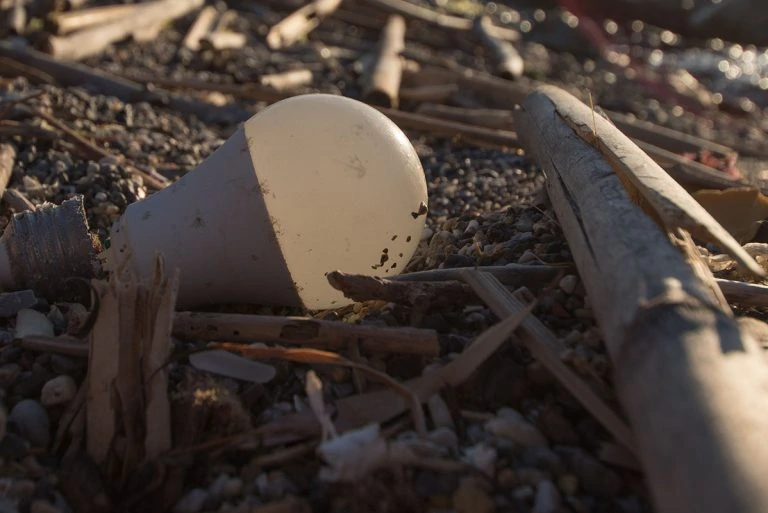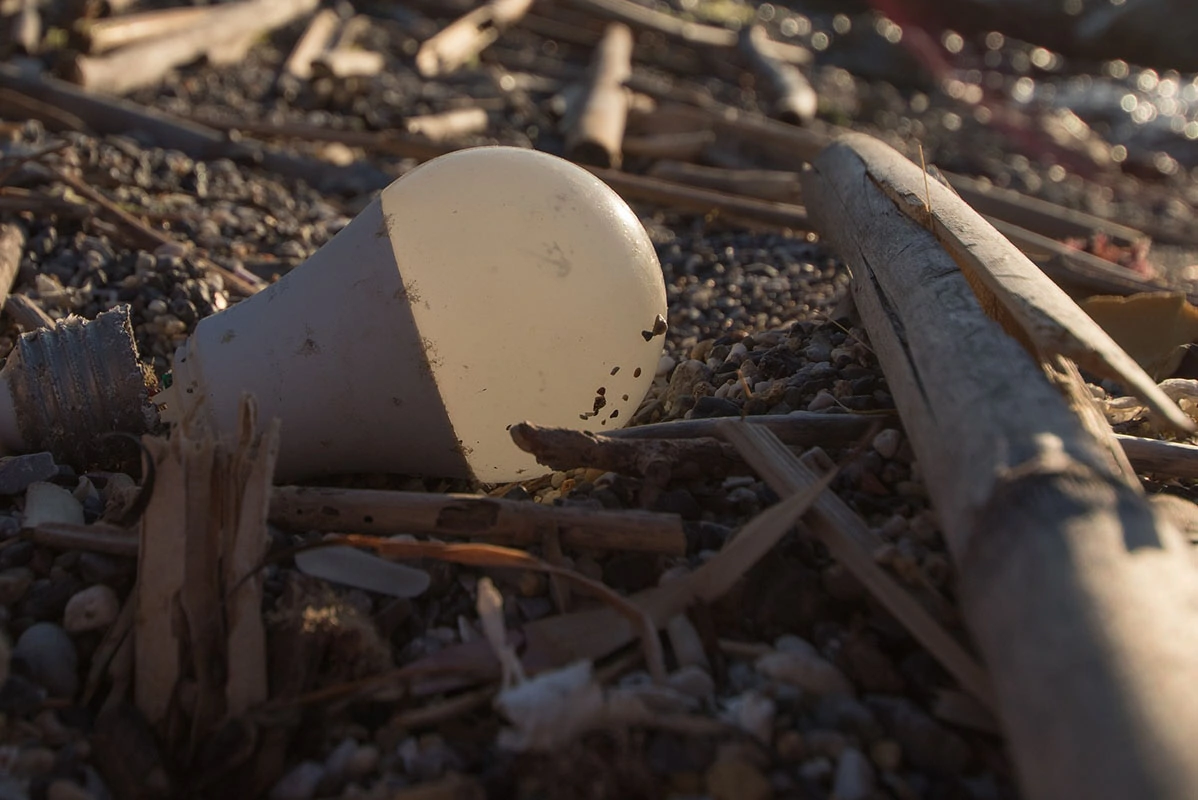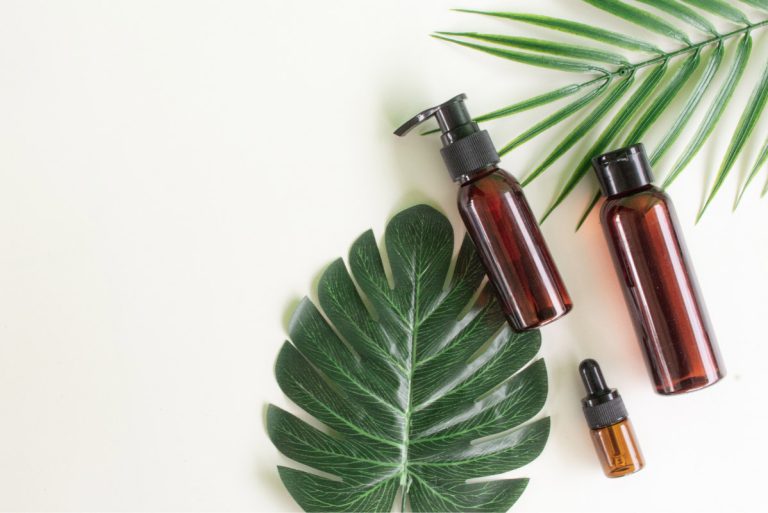LED, or light-emitting diode bulbs are highly energy-efficient, helping you to light your home while being kinder to the planet. LED light bulbs will give you around 35,000 to 50,000 hours of illumination for the fraction of the energy used by incandescent light bulbs.
However, even these light bulbs won’t remain functional forever, and if you want to be truly environmentally-friendly, you need to know how to dispose of LED light bulbs responsibly.
How to dispose of LED light bulbs responsibly
You can recycle LED bulbs, give them away if they’re in good condition, or upcycle them. If you absolutely have to throw them in the trash, it’s essential to handle these types of bulbs properly.
Recycle them
LED light bulbs are made of mostly glass, aluminum, copper, and plastic, making it even more important to recycle them so that these non-renewable materials can be recovered and reused. Luckily, this also means they are profitable and therefore relatively easy to recycle.

During the recycling process, LED lights are shredded in a machine and then processed to separate out the different materials. Facilities typically use a photopic separator or an eddy current sorter, sometimes with a magnet to remove metals, to sort the components into glass, metal, and plastic.
The recycling center will pick out the copper and aluminum pieces, as these are the most valuable materials and can be sold to be made into new products. The circuit boards are smelted down using either heat or chemical extraction to recover the precious metals they contain.
The other materials such as glass and plastic will be recycled separately if possible, otherwise they’ll be sent to landfill.
However, most municipalities don’t accept light bulbs as part of their recycling program, and this includes LEDs. You should check with your local sanitation department first, and then look for a recycling center in your area that accepts LED light bulbs.
It’s critically important to check this, as mixing light bulbs in with your other recycling when they’re not accepted this way can contaminate the rest of your recycling and mean it all ends up in landfill!
Step-by-step guide to recycling LED light bulbs
- Contact your local municipality and ask if they accept LED light bulbs for recycling. Even though they’re unlikely to take these items curbside, they may have drop-off locations or pick up LED bulbs on specific dates.
- If not, use an online search tool like Earth911 or the productcare recycling locator to find a recycling facility near you that will accept this item. Enter your zip code and the type of material you want to recycle, that is, LED light bulbs, into the tool and it will show you the closest recycling centers that accept them.
- Whether recycling your LED light bulbs through your local authority or a recycling facility, ask them how you should prepare this material before putting them out for recycling or dropping them off at the center. Some facilities want you to wrap each bulb separately in its own plastic bag to avoid breakage and keep their workers safe. They may accept broken bulbs, or could only take LED light bulbs that are intact.
- Prep the bulbs according to these instructions, then drop them off at the recycling center.
If you’re not able to recycle your old LEDs through your local authority or a recycling center, try the following options:
- Check with big box stores in your area if they run a light bulb recycling program. The Home Depot, Lowes, Menards, and True Value Hardware take LED light bulbs at various locations which they will then send for recycling.
- See if you have a Batteries Plus store in your area. Many of the brand’s locations will take old LED bulbs for recycling, but they usually charge a fee.
- Try local hardware stores, as these also sometimes accept LED light bulbs, again normally for a fee.
- Use a mail-in program like the ones offered by LampMaster, Veolia, Republic Services, and NLR.
Give them away
Do you have unused LED light bulbs in good condition that you don’t need? Given the long lifespan of these kinds of bulbs, you may have a draw full of them that you’ll never use!
In this case, it’s better to give them away to a good home rather than trying to recycle them. Ask your friends, family members, or neighbors if they could make use of them.
You could also call around to local charities to see if they need some LED lights – many organizations will appreciate all kinds of donations! You can try local thrift stores like Goodwill, homeless shelters, or non-profits that support people with light sensitivities.
LED lights would be a fitting donation for sufferers of conditions like lupus and photosensitivity, as these kinds of bulbs emit very limited amounts of UV. People with these kinds of illnesses can be highly sensitive to the UV emitted by other types of lights, which can cause headaches, dry eyes, and even rashes and lesions.
You can also send your LED lights to HolidayLEDs.com who will turn them into Christmas lights, or list them on Freecycle.
Upcycle them
Another great way to deal with your LED lights without them ending up in landfill is to upcycle them into something else.
Here are some ideas for creative things to do with old LED lights:
- Repurpose working LEDs into holiday lights
- Turn them into lighting for your indoor aquarium
- Make an LED light panel for a unique piece of home decor
- Create a light sculpture like this one, which also lets you upcycle your old paper towel rolls!
- Get really creative and make your own lit fashion – check out this tutorial to learn how
Throw them in the trash
Throwing LED light bulbs in the trash should always be your last resort, as this means sending them to landfill where the toxic metals they contain can contaminate the soil and leech into the water table.
Having said that, you may be able to legally toss LED lights in your regular household waste, though this depends on where you live. Some municipalities will accept this kind of material in their regular trash, while other areas have laws that mandate recycling LED bulbs or taking them to a special facility.
Therefore, you need to check the local rules with your local sanitation department or city council.
If you absolutely have to throw LED light bulbs in the trash and you’ve checked that it’s legal to do so, be sure to handle them correctly for everyone’s safety. Wrap them securely in newspaper or a similar material to prevent breakages and avoid them ripping your trash bag or hurting anyone handling it.
Are LED light bulbs dangerous?
Unlike other types of light bulbs, LED bulbs don’t contain mercury, but they do have small amounts of other hazardous substances such as arsenic and lead. Therefore, if you dispose of them with your regular household waste, these toxins can leach into the environment and make their way into the water table, so it’s important to dispose of them properly.
However, LED bulbs are not really dangerous to handle, as these hazardous materials are only present in very small quantities which are not enough to pose a risk to your health.
The biggest risk you’ll likely face when dealing with old LED bulbs is breakages. Be sure to wrap the bulbs properly before recycling or disposing of them – this will protect you as well as sanitation workers!
FAQs
Still not clear on how to recycle LEDs and how to handle these kinds of lights properly? Below we’ve answered some of the most frequently asked questions on the subject.
Can you recycle LEDs?
Yes, LEDs can be recycled relatively easily. Although most local authorities don’t accept LEDs as curbside, many do accept this type of material for either drop off or as part of special pick up programs.
Most recycling centers will also take LED light bulbs, and a range of big box, as well as hardware stores, accept them for recycling, though this may involve a fee. Another recycling option is mail-in programs that take LEDs, usually also for a fee.
Are LED light bulbs hazardous waste?
Depending on where you live, LED light bulbs may or may not be classified as hazardous waste under local laws. Unlike truly hazardous items such as chemical cleaners, pesticides, sharps, and flammable liquids, LED lights will not pose a direct danger to you or sanitation workers, although broken bulbs could cause cuts or abrasions.

However, LED light bulbs do cause metals that are environmental toxins and can be hazardous in large enough quantities. Therefore, it’s important to dispose of your old LEDs responsibly and handle them with care.
If you’re dealing with broken LED light bulbs, wrap them in paper and then place in a sealed container before disposing of them. Also, be sure to check with the recycling center or program whether they’ll take broken bulbs first before sending them in!
How long do LED light bulbs last?
LED light bulbs generally last around 50,000 hours. This is more than 40 times longer than traditional incandescent light bulbs, which will only last about 1,200 hours.
To put these figures into perspective, 50,000 hours of illumination translates to eight hours a day for a staggering 17 years. Eco-conscious consumers will probably turn their lights on for less than eight hours a day, especially if you’re making use of solar lighting alternatives, so you’ll likely find that your LED light bulbs will last even longer than this.
Thanks to this long life span, many of the LED light bulbs produced to date are still in use and so don’t contribute to the mountains of household waste that end up landfill every year. However, even though they’re incredibly long-lasting, LED lights do cease to work eventually, and so you need to know how to recycle them when they do.
This characteristic is also responsible for the lack of awareness about how to recycle LED light bulbs, as there aren’t too many of these bulbs entering the waste stream at the moment. In the future, as more LEDs come to the end of their life and people try to recycle them, recycling them will probably get a whole lot easier!
Wrapping up
Although LED lights are highly efficient and can last you for years, if not decades, eventually they will wear out. Given they contain toxic metals, it’s important to know how to dispose of LED light bulbs responsibly.
There are plenty of options for recycling these kinds of light bulbs, such as through special municipal programs, recycling centers, retailers, and mail-in companies. Alternatively, you can get creative and recycle them, or donate unused LED lights in good condition.
Have other old light bulbs lying around the house? Our guide to how to dispose of light bulbs responsibly covers how to recycle fluorescent tubes, CFLs, incandescent, and halogen bulbs.












